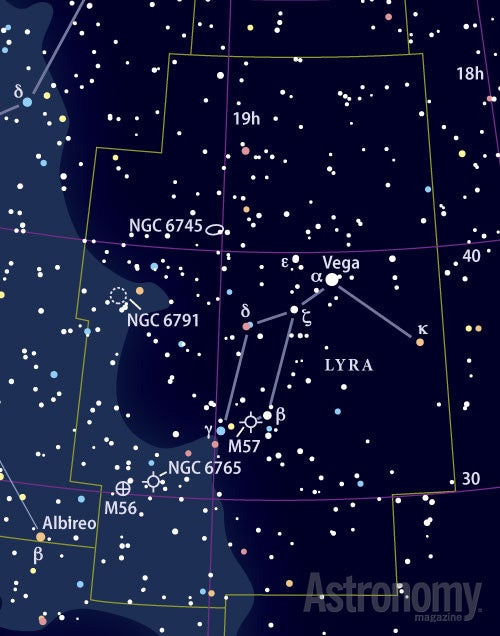Targets for August 21–28, 2014
Small telescope: Open cluster M26
Large telescope: Globular cluster M56
Large telescope: Spiral galaxy IC 4808
This week’s small-telescope target is open cluster M26 in the constellation Scutum the Shield. To find this object, draw a line from magnitude 3.9 Alpha (α) through magnitude 4.7 Delta (δ) Scuti. Then extend the line in the same direction half the distance between Alpha and Delta, and you’ll land on M26.
This cluster lies in a rich star field in a Milky Way region called the Scutum Star Cloud. It shines at magnitude 8.0 and measures 14′ across. That makes its area 20 percent that covered by the Full Moon.
Through a 4-inch scope, you’ll see two dozen stars. Increase the aperture to 12 inches, and you’ll have a good chance to resolve another 70 cluster members.
Best through a big scope
This week’s first large-telescope object is globular cluster M56 in Lyra the Harp. It shines at magnitude 8.3 and measures 7.1′ across.
Lying just under half of the way from Albireo (Beta [β] Cygni) to Gamma (γ) Lyrae, the 56th entry in French comet-hunter Charles Messier’s catalog is easy to find. From a dark site, you’ll spot it through typical binoculars. But spotting it as a fuzzy patch and seeing detail in it are two different things.
The density of stars in M56 increases dramatically as you move toward its core. And because the cluster’s individual stars aren’t all that bright, you’ll resolve them best through 8-inch or larger telescopes and at magnifications exceeding 150x. When you’re done examining the inner workings of M56, back off the power and enjoy the star field in which this cluster sits.
Not for the faint of heart
This week’s second large-scope target is spiral galaxy IC 4808 in the constellation Corona Australis the Southern Crown.
You’ll find this galaxy right on Corona Australis’ southern border with Telescopium. The easiest way to locate it is to look 3.9° west-southwest of magnitude 4.9 Beta1 (β1) Sagittarii. At magnitude 12.9, IC 4808 is one of the faintest targets in my podcast series so far, so it’s best-suited for large-scope users. Still, just catching it through a 6-inch telescope under a dark, steady sky makes a noteworthy observation.
Through a 14-inch scope at a magnification of 200x, you’ll see an oval glow twice as long as it is wide, oriented northeast to southwest, with a slightly brighter, evenly illuminated central area. The galaxy measures 1.9′ by 0.8′.
Crank the power up to 350x, and the outer region’s even brightness distribution begins to break down, especially at the southwestern end. That’s the telltale sign of spiral structure, although you won’t see this galaxy’s arms through amateur instruments.
Expand your observing at Astronomy.com
StarDome
Check out Astronomy.com’s interactive StarDome to see an accurate map of your sky. This tool will help you locate this week’s targets.
The Sky this Week
Get a daily digest of celestial events coming soon to a sky near you.
Observing Talk
After you listen to the podcast and try to find the objects, be sure to share your observing experience with us by leaving a comment at the blog or in the Reader Forums.











